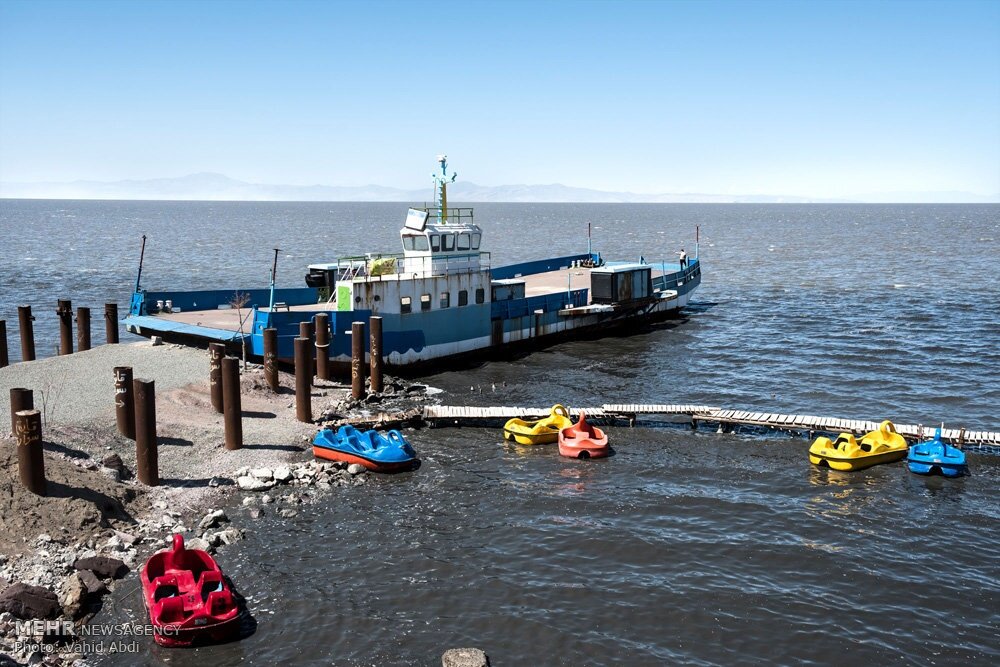Lake Urmia in best condition over past decade

TEHRAN – About 10 years ago, Lake Urmia, northwestern Iran, began its gradual death. Photos of the country's largest saltwater lake were going viral those days, worrying every Iranian. But the lake is now experiencing its best condition over the past decade, turning back to the former glory.
‘Let’s go cry and fill Lake Urmia with our tears’ was a poem chanted by the people as a way to express sympathy over the falling of the precious lake.
As news spread that Lake Urmia had dried up to 80 percent, experts warned that if restoration measures are not taken, the population living along the lake would be forced to migrate due to sand and dust storms.
Issa Kalantari, head of the Department of Environment, also warned that if Lake Urmia dried up, the city of Tabriz would have to be evacuated.
Now, however, after several years of concern and regret for Lake Urmia, the spectacular blue-white scene is catching every eye, and the level of the second largest salt lake of the world, with a figure of 1271.70, has hit a 10-year record.
According to the latest statistics of the Meteorological Organization, since the beginning of this water year, West Azarbaijan province received 279.2 millimeters of rain, which demonstrates an increase of 21 percent compared to the long-term average. Also, 396 mm of rain and snow fell in the province last year. Which was 71 percent higher than the long-term average.
The above normal levels of rain came to help conservation measures to preserve the Lake Urmia which have now increased by 37 centimeters compared to [the Iranian calendar month of Farvardin (March 19- April 18)] last year.
Farhad Sarkhosh, head of the Lake Urmia Restoration Program’s office in West Azarbaijan province said that the lake’s level has reached 1,271 meters and 70 centimeters, which is 37 centimeters higher than the last year’s level, he stated, IRNA reported.
The lake's water volume was estimated at more than 4.620 billion cubic meters, which indicates an increase of 1.010 billion cubic meters compared to the last year, he highlighted.
He went on to say that Lake Urmia’s surface area has now reached more than 3,093 square kilometers, adding that the figure has increased by 244 square kilometers compared to the same period last year.
In previous years, not providing the water right of the lake was considered as the most important cause of its gradual drying up; in the past, the main rivers in the catchment area were not dredged and due to sedimentation, the water that entered them had no way to Lake Urmia, but now all the rivers at the entrance of the dredging lake are connected to its main body, Sarkhosh explained.
The two rivers of Zarrineh Rud and Simineh Rud are among the largest ones in the Urmia Lake catchment area, the two are connected to the main body of the lake by a 25-kilometer canal, which was built to prevent flooding, and damage to surrounding villages during natural incidents, he also said.
He went on to point out that excessive farming and cultivation of water consuming crops in the surrounding areas are other causes of its drying up. Although this factor still threatens the Lake, so that the Restoration Program seeks to ensure the sustainability of the lake by reducing water consumption by 40 percent in agriculture.
Therefore, modern irrigation and modification of cultivation patterns are on the agenda, Sarkhosh said, pointing out that in the past, water-consuming crops such as beets and corn were abundantly cultivated in its catchment area, but we improved and replaced medicinal plants such as saffron to minimize the use of water, he explained.
Emphasizing that our efforts to revitalize Lake Urmia are still ongoing, he noted that since the beginning of the Program, many people believed that the lake could not be returned to life.
However, we have been working for three years to stabilize the Lake’s level, and now, to improve the situation and prevent a recurrence of the crisis, we must continue to take some measures for years to come; also, Lake Urmia must always have specific management to be able to provide its water, he stated.
This is while Lake Urmia still needs 9.5 billion cubic meters of water to reach its ecological level of 1274.10, Sarkhosh said, expressing hope that with the completion of projects designed to save the Lake, they will be able to increase 3.5 million cubic meters of water into the lake annually to reach its ecological level.
These days, life has returned to Lake Urmia. The lake now has so much water that tourists can swim in its shiny water and birds and aquatic species such as flamingos and Artemia have returned to it, but we should not forget the hard days it went through. Lake Urmia still has a long way to completely survive, and neglect can threaten this precious gem of Iran again.
Shared between West Azarbaijan and East Azarbaijan provinces in northwestern Iran, Lake Urmia, was once the largest salt-water lake in West Asia. It was home to many migratory and indigenous animals including flamingos, pelicans, egrets, and ducks and attracted hundreds of tourists every year who had bathed in the water to take advantage of the therapeutic properties of the lake.
However, decades of long-standing drought spells and elevated hot summer temperatures that speed up evaporation as well as increased water demands in the agriculture sector shrank the lake drastically. In 1999 the volume of water which was at 30 billion cubic meters drastically decreased to half a billion cubic meters in 2013. Moreover, the lake surface area of 5,000 square kilometers in 1997 shrunk to one-tenth of that to 500 square kilometers in 2013.
FB/MG
